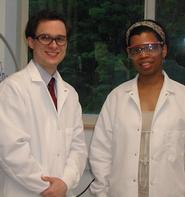
Tom Nevers '10 and his senior thesis advisor, Assistant Professor of Chemistry Camille Jones, have published an article titled "Temperature-dependent distortions of the host structure of propylene oxide clathrate hydrate," published in The Journal of Physical Chemistry C (published in the March 11 print issue and Feb. 17 online). The article is a result of a detailed structural study they performed of clathrate hydrate, an arrangement of atoms and molecules in an ice-like compound.
Clathrate hydrates, or their naturally-occurring variety called gas hydrates, have been in the news lately. They are the ice-like materials that have contributed to the clogging and failure of the oil line beneath the British Petroleum-leased Deepwater Horizon oil rig which is spilling oil into the Gulf of Mexico.
The particular clathrate hydrates studied in Jones’ lab are not naturally occurring but rather contain small molecules of a chemical compound called propylene oxide trapped inside a network of water-based cages that make up the hydrate network. Taking data measured by Jones with high-resolution, constant-wavelength neutron powder diffraction data, Nevers analyzed the hydrogen-bond geometry in the cage-like water structure and showed that it is significantly different from that of normal ice, but that it displays similarities to high-pressure forms of ice and to crystalline hydrates of inorganic salts. He described how the structure can be divided into three regimes of temperature, where the bond distances and angles display greater or lesser similarity to those of ice and how the structure is related to size and shape of the propylene oxide “guest” molecules. As in other hydrates experiencing strain from the enclathration of large guests such as propylene oxide, the structure must distort as it tries to expand as it gets warmer.
Their work shows that the variation in the angles and distances of chemical bonds in this material provides a quantitative indicator of the strength of guest-host interactions and the deviation of the thermodynamic properties of hydrate hosts from those of ice. Currently, Nevers is working as first author with Jones on a manuscript for publication adapted from his senior thesis on the effect of salt additives on the stability of clathrate hydrates. He will begin medical school at Tufts University this fall.
Clathrate hydrates, or their naturally-occurring variety called gas hydrates, have been in the news lately. They are the ice-like materials that have contributed to the clogging and failure of the oil line beneath the British Petroleum-leased Deepwater Horizon oil rig which is spilling oil into the Gulf of Mexico.
The particular clathrate hydrates studied in Jones’ lab are not naturally occurring but rather contain small molecules of a chemical compound called propylene oxide trapped inside a network of water-based cages that make up the hydrate network. Taking data measured by Jones with high-resolution, constant-wavelength neutron powder diffraction data, Nevers analyzed the hydrogen-bond geometry in the cage-like water structure and showed that it is significantly different from that of normal ice, but that it displays similarities to high-pressure forms of ice and to crystalline hydrates of inorganic salts. He described how the structure can be divided into three regimes of temperature, where the bond distances and angles display greater or lesser similarity to those of ice and how the structure is related to size and shape of the propylene oxide “guest” molecules. As in other hydrates experiencing strain from the enclathration of large guests such as propylene oxide, the structure must distort as it tries to expand as it gets warmer.
Their work shows that the variation in the angles and distances of chemical bonds in this material provides a quantitative indicator of the strength of guest-host interactions and the deviation of the thermodynamic properties of hydrate hosts from those of ice. Currently, Nevers is working as first author with Jones on a manuscript for publication adapted from his senior thesis on the effect of salt additives on the stability of clathrate hydrates. He will begin medical school at Tufts University this fall.
